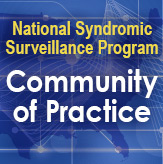Kansas Adds Emergency Department Data to Weather-related Risk Assessment
To improve emergency preparedness and understand how weather hazards affect Kansans, the Kansas Department of Health and Environment (KDHE) integrated syndromic data from emergency departments into a public health jurisdictional risk assessment.
KDHE analysts queried electronic health data to detect illnesses and injuries related to the most common hazards in Kansas: severe storms, floods, and winter weather. They looked at diagnosis codes and examined free-text queries to get a complete and detailed picture of why people sought healthcare.
Analysts observed that many injuries associated with weather-related events had not been reliably captured by diagnosis (external cause) codes alone. They found that the free-text queries improved accuracy, and by examining patient-level data in such detail, analysts were able to categorize injury and illness and determine the specific hazards associated with each. This analysis can assist public health in targeting preparedness resources and developing more evidence-based risk messaging.
Public Health Problem
After the 2002 Public Health Emergency Preparedness cooperative agreement was implemented, the Kansas Department of Health and Environment (KDHE) set up a jurisdictional risk assessment to describe the burden of injury and illness on Kansans from common weather-related hazards. KDHE analysts sought to improve the comprehensiveness of the report by integrating emergency department (ED) data collected from 2016–2019.
Actions Taken
To capture ED data, KDHE used the Electronic Surveillance System for the Early Notification of Community Based Epidemics (ESSENCE). ESSENCE is the National Syndromic Surveillance Program’s secure, web-based tool to operationalize the public health surveillance workflow. It allows analysts across all levels of public health to collaborate; investigate changes in trends; and analyze, visualize, and share data. KDHE analysts developed ESSENCE queries to capture illnesses and injuries related to the most common hazards in Kansas: severe storms, floods, and winter weather. They used the free-text fields in ESSENCE to search chief complaint, admit reason, and triage notes for counts of direct and indirect injury or illness. Findings were summarized in the jurisdictional risk assessment.
Outcome
In Kansas, diagnosis codes captured less than 10% of total medical impacts detected in ESSENCE for weather-related events. By searching diagnosis codes for external cause alone, KDHE analysts identified only 27 instances of illness or injury in their ED data for 2016–2019. Most illnesses and injuries (23) were associated with lightning, with the remaining 4 from floods. No events were captured with the external cause code for any other cataclysmic storm or for ice, snow, or blizzard. By running free-text queries in ESSENCE, the analysts identified at least 80 ED visits related to severe storms, 38 ED visits related to floods, and 752 ED visits related to winter weather. They observed that even direct injuries associated with flood waters or storm debris had not been reliably captured by external cause codes alone and that the free-text queries improved accuracy. By examining patient-level data in ESSENCE using fields such as chief complaint or triage notes, they were able to determine the circumstances that led to a specific injury or illness and provide a qualitative analysis of morbidity events.
Contact
Daniel J. Neises
Kansas Department of Health and Environment
daniel.neises@ks.gov
Office of Public Health Data, Surveillance, and Technology
www.cdc.gov/nssp
This success story shows how NSSP
- Improves Data Representativeness
- Improves Data Quality, Timeliness, and Use
- Strengthens Syndromic Surveillance Practice
- Informs Public Health Action or Response
The findings and outcomes described in this syndromic success story are those of the authors and do not necessarily represent the official position of the National Syndromic Surveillance Program or the Centers for Disease Control and Prevention.
